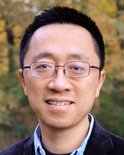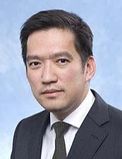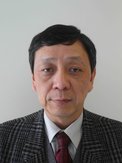KEYNOTES

Dr Hui Lei
CTO, Watson Health Cloud
IBM
Tuesday, 30 May 2017 | 09:00 – 09:50
What Makes Computing Smart?
Researchers and practitioners have been pursuing smart computing for decades. The initial focus was on smart appliances and gadgets enabled by instrumenting and connecting everyday objects. Then came smart environments such as smart offices and smart homes that were interwoven with sensors, actuators, and computational elements and that were personalized and adaptive. More recently, the advent of technologies like mobile crowdsensing and the Internet of Things has resulted in smart systems at the societal scale, including many smart city applications. In spite of the tremendous growth in scale, smart computing systems have stayed at more or less the same level of smartness so far. The smartness has mostly stemmed from the capabilities of detecting dynamic user context and responding to that context autonomously. Going forward, an important direction is to enable a significantly heightened level of smartness in computing systems, by leveraging developments in big data and cognitive computing. Applications that integrate big data across the board and are cognizant promise to be more insightful and offer augmented intelligence to humans. In this talk, I will discuss the implications of big data and cognitive technologies on smart computing. I will draw upon our experience at IBM Watson Health, and discuss how big data and cognitive computing can come together to enable innovative health solutions that address many clinical, societal, and economic issues. I will present use cases, highlight the challenges, describe our approaches, and relate to client experiences.
Biography: Dr Hui Lei is Chief Technology Officer of IBM Watson Health Cloud, an IBM Distinguished Engineer, and an IBM Master Inventor. Previously he was Senior Manager, Cloud Platform Technologies at the IBM T. J. Watson Research Center, and led IBM’s worldwide research strategies in cloud infrastructure services and cloud managed services. His technical interests include mobile and pervasive computing, cloud computing, big data, and enterprise computing. His technical vision and creative contributions have impacted many commercial software products and services, and have resulted in over 70 patents. He is a Fellow of the IEEE, Editor-in-Chief of the IEEE Transactions on Cloud Computing, and a past Chair of the IEEE Computer Society Technical Committee on Business Informatics and Systems. He has taken part in many international conferences as a steering committee chair, general chair, technical program chair, or keynote speaker. He was recognized with an IEEE Computer Society Technical Achievement Award in 2017 and an IEEE Computer Society Distinguished Service Award in 2014. He received his PhD in Computer Science from Columbia University.
CTO, Watson Health Cloud
IBM
Tuesday, 30 May 2017 | 09:00 – 09:50
What Makes Computing Smart?
Researchers and practitioners have been pursuing smart computing for decades. The initial focus was on smart appliances and gadgets enabled by instrumenting and connecting everyday objects. Then came smart environments such as smart offices and smart homes that were interwoven with sensors, actuators, and computational elements and that were personalized and adaptive. More recently, the advent of technologies like mobile crowdsensing and the Internet of Things has resulted in smart systems at the societal scale, including many smart city applications. In spite of the tremendous growth in scale, smart computing systems have stayed at more or less the same level of smartness so far. The smartness has mostly stemmed from the capabilities of detecting dynamic user context and responding to that context autonomously. Going forward, an important direction is to enable a significantly heightened level of smartness in computing systems, by leveraging developments in big data and cognitive computing. Applications that integrate big data across the board and are cognizant promise to be more insightful and offer augmented intelligence to humans. In this talk, I will discuss the implications of big data and cognitive technologies on smart computing. I will draw upon our experience at IBM Watson Health, and discuss how big data and cognitive computing can come together to enable innovative health solutions that address many clinical, societal, and economic issues. I will present use cases, highlight the challenges, describe our approaches, and relate to client experiences.
Biography: Dr Hui Lei is Chief Technology Officer of IBM Watson Health Cloud, an IBM Distinguished Engineer, and an IBM Master Inventor. Previously he was Senior Manager, Cloud Platform Technologies at the IBM T. J. Watson Research Center, and led IBM’s worldwide research strategies in cloud infrastructure services and cloud managed services. His technical interests include mobile and pervasive computing, cloud computing, big data, and enterprise computing. His technical vision and creative contributions have impacted many commercial software products and services, and have resulted in over 70 patents. He is a Fellow of the IEEE, Editor-in-Chief of the IEEE Transactions on Cloud Computing, and a past Chair of the IEEE Computer Society Technical Committee on Business Informatics and Systems. He has taken part in many international conferences as a steering committee chair, general chair, technical program chair, or keynote speaker. He was recognized with an IEEE Computer Society Technical Achievement Award in 2017 and an IEEE Computer Society Distinguished Service Award in 2014. He received his PhD in Computer Science from Columbia University.

Prof. Andrew Lim
Department of Industrial Systems Engineering and Management
National University of Singapore
Tuesday, 30 May 2017 | 10:05 – 10:55
Smart Nation Initiatives in Singapore
Singapore’s prime minister Lee said: “Singapore aims to be an outstanding city in the we should aim to be an outstanding city in the world. An outstanding place for people to live, work and play in, where the human spirit flourishes. In this talk, we shall highlight some of the challenges and rewards in this endeavour.
Biography: Professor Andrew Lim is Head of the Department of Industrial Systems Engineering and Management at the National University of Singapore (NUS). As an academic-technopreneur, Andrew’s work draws from knowledge in computing, engineering and commerce to drive the design and development of innovative and effective industrial systems and processes. As a technopreneur, Andrew has spearheaded numerous industry projects that have not only resulted in multi-million dollar savings for his clients, his work has also been recognized through the numerous organisational, national and international awards and innovation prizes that he has won. As an academic, Andrew’s work into helping companies and organizations compete effectively have been published in key journals in Operations Research and Management Science, and disseminated via international conferences and professional seminars. Before Andrew was recruited by NUS under The National Research Foundation's Returning Singaporean Scientists Scheme in 2016, he spent more than a decade in Hong Kong where he held professorships in The Hong Kong University of Science and Technology and The City University of Hong Kong. In 2013, Andrew was recruited by Nanjing University under the Thousand Talents Program that was launched by the Chinese government in 2008. Andrew is currently involved in a number of initiatives. While some of them involve big data analytics, others are concerned with demand generation and supply management problems in the domains of healthcare, logistics and transportation. Last but not least, he is excited for the opportunity to share his experience to foster the entrepreneurial spirit among colleagues and students.
Department of Industrial Systems Engineering and Management
National University of Singapore
Tuesday, 30 May 2017 | 10:05 – 10:55
Smart Nation Initiatives in Singapore
Singapore’s prime minister Lee said: “Singapore aims to be an outstanding city in the we should aim to be an outstanding city in the world. An outstanding place for people to live, work and play in, where the human spirit flourishes. In this talk, we shall highlight some of the challenges and rewards in this endeavour.
Biography: Professor Andrew Lim is Head of the Department of Industrial Systems Engineering and Management at the National University of Singapore (NUS). As an academic-technopreneur, Andrew’s work draws from knowledge in computing, engineering and commerce to drive the design and development of innovative and effective industrial systems and processes. As a technopreneur, Andrew has spearheaded numerous industry projects that have not only resulted in multi-million dollar savings for his clients, his work has also been recognized through the numerous organisational, national and international awards and innovation prizes that he has won. As an academic, Andrew’s work into helping companies and organizations compete effectively have been published in key journals in Operations Research and Management Science, and disseminated via international conferences and professional seminars. Before Andrew was recruited by NUS under The National Research Foundation's Returning Singaporean Scientists Scheme in 2016, he spent more than a decade in Hong Kong where he held professorships in The Hong Kong University of Science and Technology and The City University of Hong Kong. In 2013, Andrew was recruited by Nanjing University under the Thousand Talents Program that was launched by the Chinese government in 2008. Andrew is currently involved in a number of initiatives. While some of them involve big data analytics, others are concerned with demand generation and supply management problems in the domains of healthcare, logistics and transportation. Last but not least, he is excited for the opportunity to share his experience to foster the entrepreneurial spirit among colleagues and students.

Prof. Teruo Higashino
Graduate School of Information Science and Technology
Osaka University
Wednesday, 31 May 2017 | 09:00 – 09:50
IoT based Social CPS Research for Smart Cities Resilient to Disasters
Recently, sensing technology and IoT (Internet of Things) have much attention for designing and developing affluent and smart social systems. Here, we focus on geospatial sensing data welled out continuously everywhere and consider how we can treat such huge sensing data. We introduce the notion of “Edge Computing” and discuss how we can apply this notion for building future smart cities resilient to disasters. Next, we introduce our recent IoT based social cyber physical system (CPS) research for disaster mitigation in Japan and energy reduction of commercial complex. We apply heterogeneous crowd sensing techniques to generate a realistic human mobility in urban areas. The techniques are used to reproduce passages, add normal and emergency pedestrian flows and check efficiency of evacuation plans on 3D map so that local governments can make efficient evacuation plans. We have combined such mobility prediction techniques with real-time weather data, and proposed methods for efficient snow removal and commuting time prediction in heavy snowfall areas such as Sapporo City. The mobility prediction is also used for energy reduction of commercial complex. We install multiple motion sensors at walls and ceilings in commercial buildings, and estimate crowd densities and their flows in a target building. Based on the positions of air conditioners in the building, their temperatures and estimated crowd densities, we calculate how surrounding temperatures vary using computational fluid simulation in advance, and indicate in real-time which air conditioners should increase/decrease their cooling/heating capacities so that the comfort indexes of crowd in the target areas are maximized. Finally, we discuss about the dependability of such smart computing systems.
Biography: Teruo Higashino is Professor of Graduate School of Information Science and Technology, Osaka University, Japan. He has been leading Mobile Computing Laboratory since 2002. He is studying about algorithms, software and design methodologies concerning with mobile/ubiquitous computing, crowd sensing, ITS, Cyber Physical Systems (CPS), ICT for disaster mitigation and green innovation, and so on. He is Steering Committee Member of IEEE ICNP, IEEE P2P and ATVA conferences. He served on Program (General) Chair of well-known international conferences such as ICNP2010, P2P2011, SSS2013, ICDCS2016 and so on. He was Senior Program Officer, Research Center for Science Systems, Japan Society for the Promotion of Science (JSPS) from 2013 to 2016. He serves on Associate Editor of IEEE Trans. on Mobile Computing (TMC). Currently, he is Vice-President of Information Processing Society of Japan (IPSJ) and Council Member of Science Council of Japan (SCJ). He is IEEE Senior member, and Fellow of IPSJ.
Graduate School of Information Science and Technology
Osaka University
Wednesday, 31 May 2017 | 09:00 – 09:50
IoT based Social CPS Research for Smart Cities Resilient to Disasters
Recently, sensing technology and IoT (Internet of Things) have much attention for designing and developing affluent and smart social systems. Here, we focus on geospatial sensing data welled out continuously everywhere and consider how we can treat such huge sensing data. We introduce the notion of “Edge Computing” and discuss how we can apply this notion for building future smart cities resilient to disasters. Next, we introduce our recent IoT based social cyber physical system (CPS) research for disaster mitigation in Japan and energy reduction of commercial complex. We apply heterogeneous crowd sensing techniques to generate a realistic human mobility in urban areas. The techniques are used to reproduce passages, add normal and emergency pedestrian flows and check efficiency of evacuation plans on 3D map so that local governments can make efficient evacuation plans. We have combined such mobility prediction techniques with real-time weather data, and proposed methods for efficient snow removal and commuting time prediction in heavy snowfall areas such as Sapporo City. The mobility prediction is also used for energy reduction of commercial complex. We install multiple motion sensors at walls and ceilings in commercial buildings, and estimate crowd densities and their flows in a target building. Based on the positions of air conditioners in the building, their temperatures and estimated crowd densities, we calculate how surrounding temperatures vary using computational fluid simulation in advance, and indicate in real-time which air conditioners should increase/decrease their cooling/heating capacities so that the comfort indexes of crowd in the target areas are maximized. Finally, we discuss about the dependability of such smart computing systems.
Biography: Teruo Higashino is Professor of Graduate School of Information Science and Technology, Osaka University, Japan. He has been leading Mobile Computing Laboratory since 2002. He is studying about algorithms, software and design methodologies concerning with mobile/ubiquitous computing, crowd sensing, ITS, Cyber Physical Systems (CPS), ICT for disaster mitigation and green innovation, and so on. He is Steering Committee Member of IEEE ICNP, IEEE P2P and ATVA conferences. He served on Program (General) Chair of well-known international conferences such as ICNP2010, P2P2011, SSS2013, ICDCS2016 and so on. He was Senior Program Officer, Research Center for Science Systems, Japan Society for the Promotion of Science (JSPS) from 2013 to 2016. He serves on Associate Editor of IEEE Trans. on Mobile Computing (TMC). Currently, he is Vice-President of Information Processing Society of Japan (IPSJ) and Council Member of Science Council of Japan (SCJ). He is IEEE Senior member, and Fellow of IPSJ.